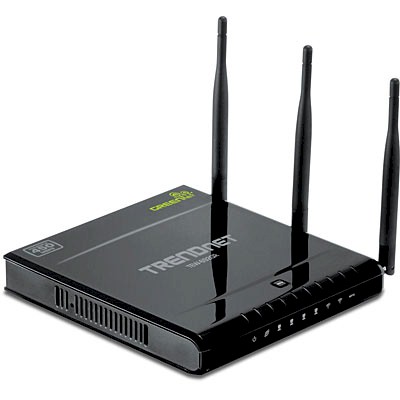
| At a glance | |
|---|---|
| Product | TRENDnet 450Mbps Concurrent Dual Band Wireless N Router (TEW-692GR) [Website] |
| Summary | Simultaneous dual-band 802.11n router with Gigabit ports based on Ralink silicon and supporting three-stream N on both bands. Not Wi-Fi Certified. |
| Pros | • Supports 450 Mbps maximum link rate on both bands • Gigabit ports |
| Cons | • Poor range performance on both bands • Very high throughput variation in some modes |
Typical Price: $99 Buy From Amazon
Overview
I’ve had TRENDnet’s first simultaneous dual-band three-stream-on-both-bands router sitting in my "To Test" pile for longer than it should have, mainly because I was avoiding the tedium of executing the eight wireless test runs that it takes to fully test it. But this weekend’s hurricane gave me a reprieve from yard work and forced me to face the music and git ‘er done.
The 692GR’s physical appearance is a bit different from the TEW-691GR three-stream-on-2.4 GHz sibling I first reviewed over a year ago, then updated with a full set of wireless tests with a two-stream N client a few months later and finally with a bona fide three-stream N client last month. Where the 691GR has a more familiar antennas-on-the-rear configuration, the 692GR’s three movable, but not upgradable external dipole antennas are mounted on its side.
Figure 1 shows the front panel indicators and rear panel connectors that adorn the glossy black plastic case. There are no mounting screw or ventilation slots on the bottom of the case and note that the power switch is not present on the U.S. model that I received for test.
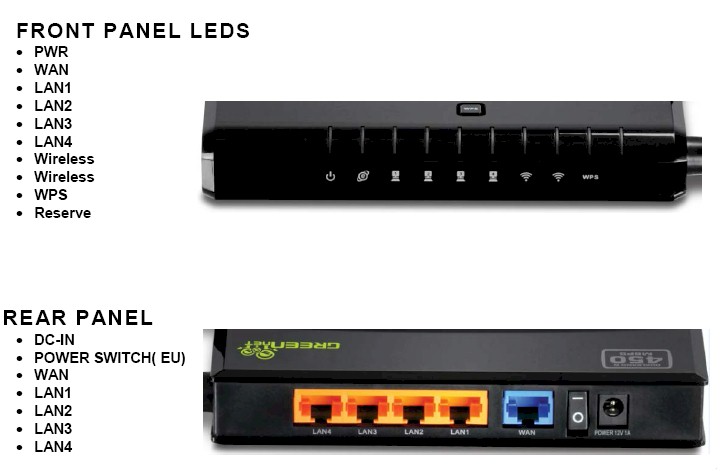
Figure 1: TRENDnet TEW-692GR front and rear panel callouts
Inside
The FCC ID document photo in Figure 2 is a bit fuzzy (Figure 2). But the FCC ID internal photo document has plenty of close-up details for component identification. Like the 691GR, the 692GR uses Ralink radios and CPU and a Qualcomm / Atheros switch. But enabling three-stream operation on both bands simultaneously required some component changes.
A Ralink RT3883F 802.11n 2.4/5GHz 3T3R 450/450Mbps Single Chip AP/Router SoC still serves as the router’s main processor and also handles 2.4 GHz band duties. For the 5 GHz band, TRENDnet put in a Ralink RT3593 dual-band 3×3 N client SoC.
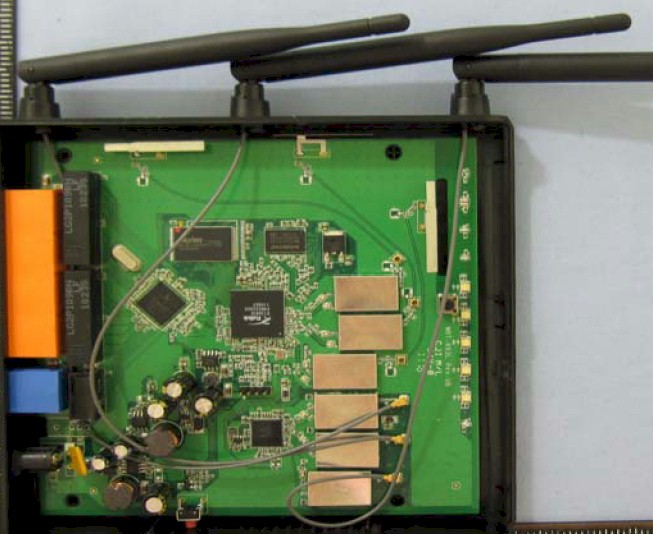
Figure 2: TRENDnet TEW-692GR inside
Both radios have Microchip outboard amplifiers in each of their three transmit / receive chain—SST12LP15A for 2.4 GHz and SST11LP12 for 5 GHz. That’s what is under the little rectangular RF "cans" you see in the photo.
If you look closely at Figure 2, you’ll see only one radio (for 5 GHz) connects to the external antennas. The 2.4 GHz radio uses three internal formed-metal antennas affixed to the board at the top and top-right of the photo.
TRENDnet made an intriguing choice in the Qualcomm / Atheros AR8327 that provides the single Gigabit WAN and four switched Gigabit LAN ports. Its datasheet reveals that it has both managed switch features and hardware NAT, neither of which appear to be used in the 692GR. 64 MB of RAM and 8 MB of flash finish up the design.
Features
Aside from the separate controls for the dual 2.4 and 5 GHz radios, the 692GR’s feature set hews close to that of TRENDnet’s other routers. Figure 3 provides a taste of the admin GUI, which was generally responsive and lets you do short saves on many of individual pages before you have to wait through a 30 second-or-so reboot cycle to make them stick.
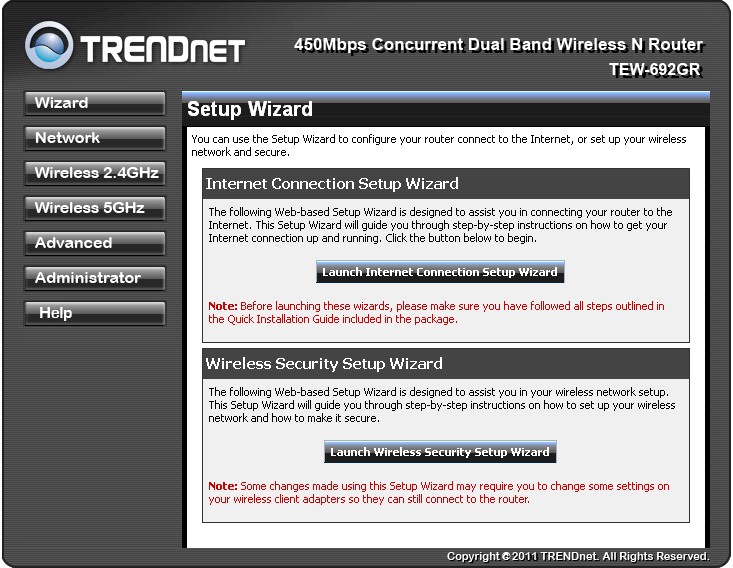
Figure 3: TRENDnet TEW-692GR Wizard page
Routing features include most of the usual suspects including:
- Static, DHCP, PPPoE, PPTP, L2TP WAN connections with MTU adjust for all
- DHCP server with reservations
- Uplink only four-level QoS
- DMZ
- Static and RIP dynamic routes
- Schedulable Single port forwarding (Virtual Server) with separate public and private ports
- Schedulable port range forwarding
- Schedulable triggered port forwarding
- Schedulable outbound service blocking
- Schedulable URL filtering
- Inbound IP address filtering
- UPnP support
- WAN ping block
- DynDNS.com dynamic DNS support
- POP, SMTP, RTP, RTSP, WMP/MMS, SIP, H.323, FTP, TFTP, Telnet, MSN messenger and IPsec ALGs
There is no HTTPs support for the admin server.
Figure 4 shows the 2.4 GHz radio’s basic settings, which are duplicated on the 5 GHz side. Note you get four SSIDs on each radio, with each SSID getting its own security mode and MAC association filters.
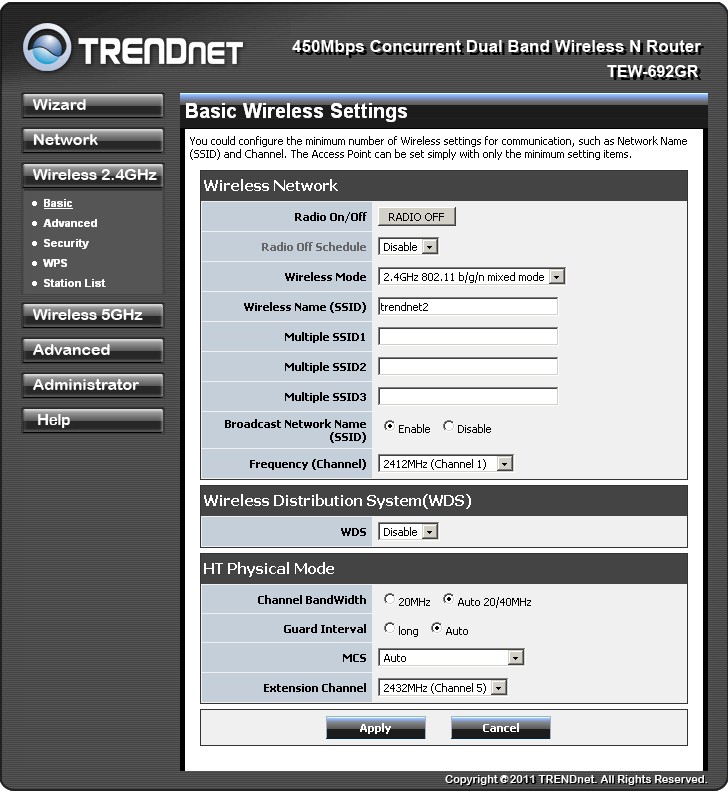
Figure 4: TRENDnet TEW-692GR Wireless basic settings
Unfortunately, there are no controls to keep wireless clients isolated from each other or for separating wireless from wired traffic. Full / half / low transmit power control is found on the Advanced pages for each radio.
I’ve put a few other admin screenshots along with a few board component details in the gallery below. For a full feature tour, use the emulator and download the user manual.
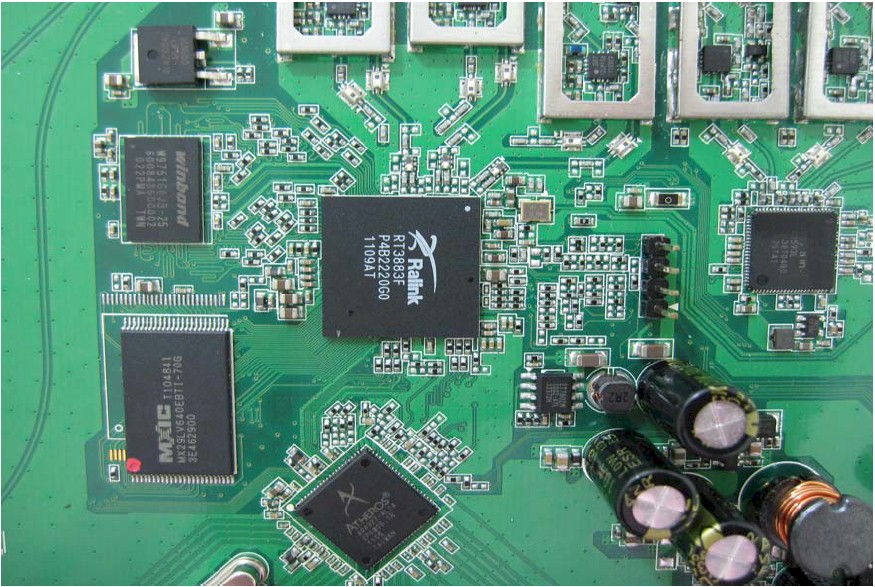
Close-up of key board components showing the Ralink RT3883F CPU and 2.4 GHz radio
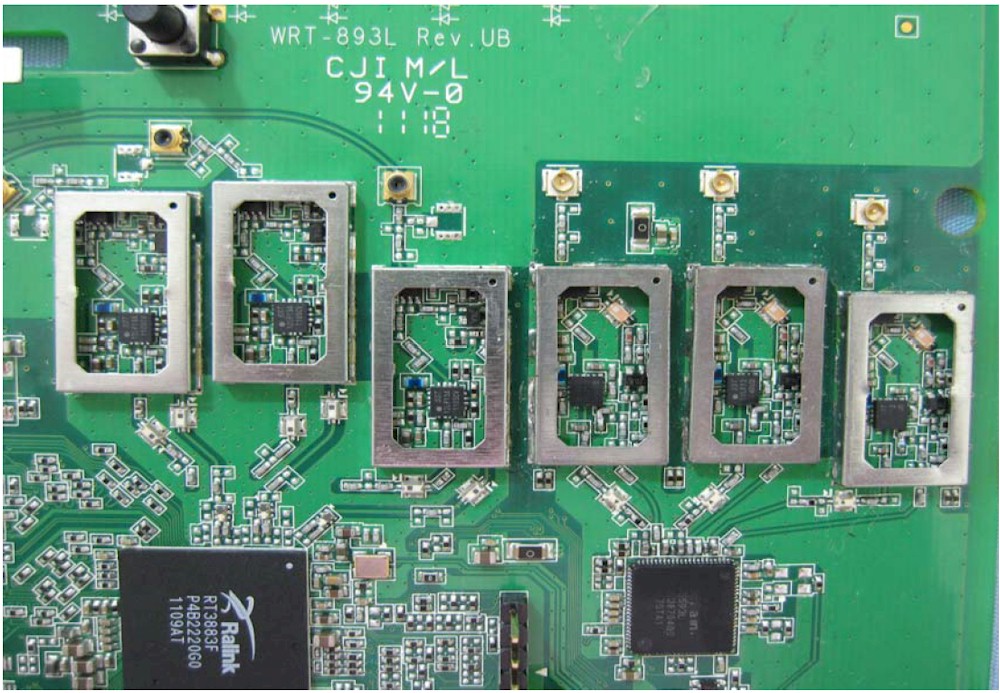
Detail of the Microchip outboard RF amplifiers for both radios.

You launch two wizards from this page

Basic wireless settings include four SSIDs for each radio, ability to force the maximum transmit level (MCS) and enable WDS bridging / repeating
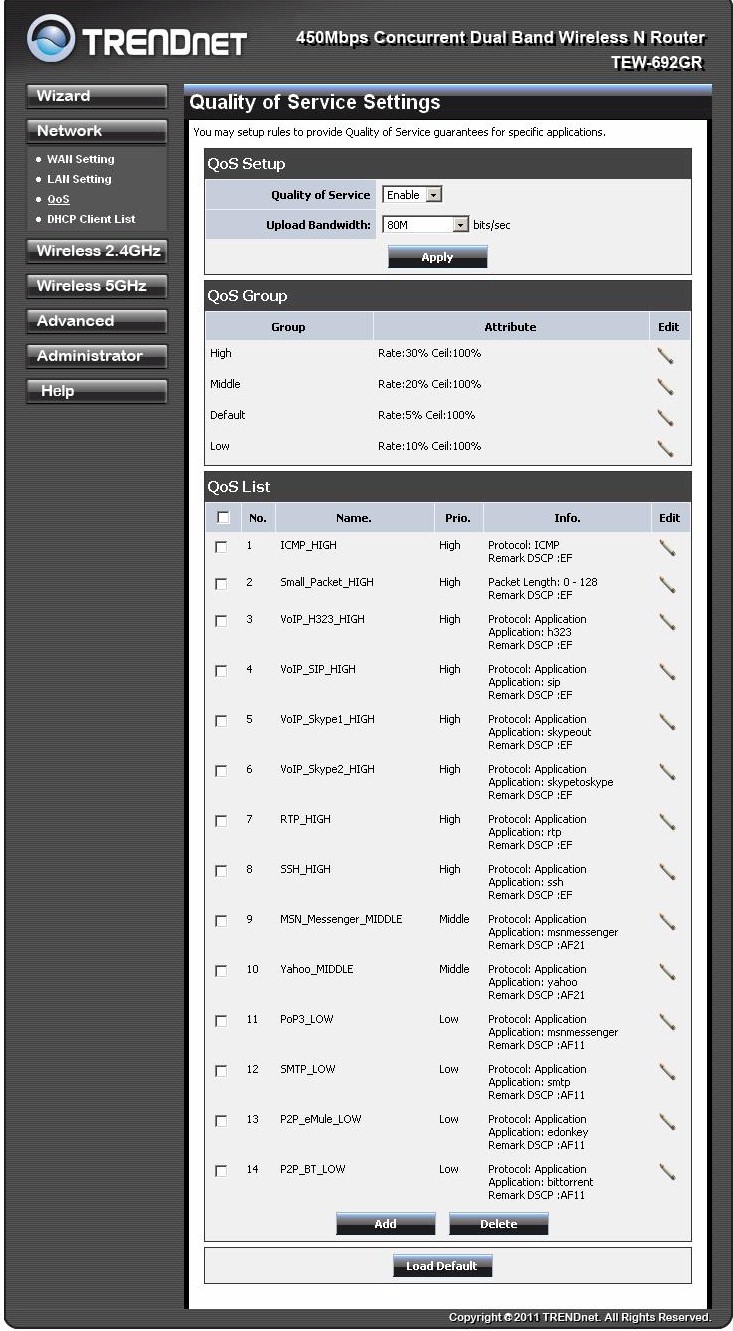
Setting the four-level uplink QoS requires setting the upload bandwidth first (80 Mbps maximum setting allowed). For each of the four QoS leels you can tweak the % of upload bandwidth allocated.
Routing Performance
Routing performance for the 692GR using our standard test method is summarized in Table 1 and Figure 5 shows the composite IxChariot plot for the three routing speed tests.
| Test Description | Throughput – (Mbps) |
|---|---|
| WAN – LAN | 277 |
| LAN – WAN | 269 |
| Total Simultaneous | 272 |
| Maximum Simultaneous Connections | 14,976 |
| Firmware Version | 1.0.0.0, 1-Jul-2011 |
Table 1: Routing throughput
Throughput is pretty steady for both unidirectional and simultaneous tests. Note also that in the simultaneous test, both up and downlink throughput is the same.
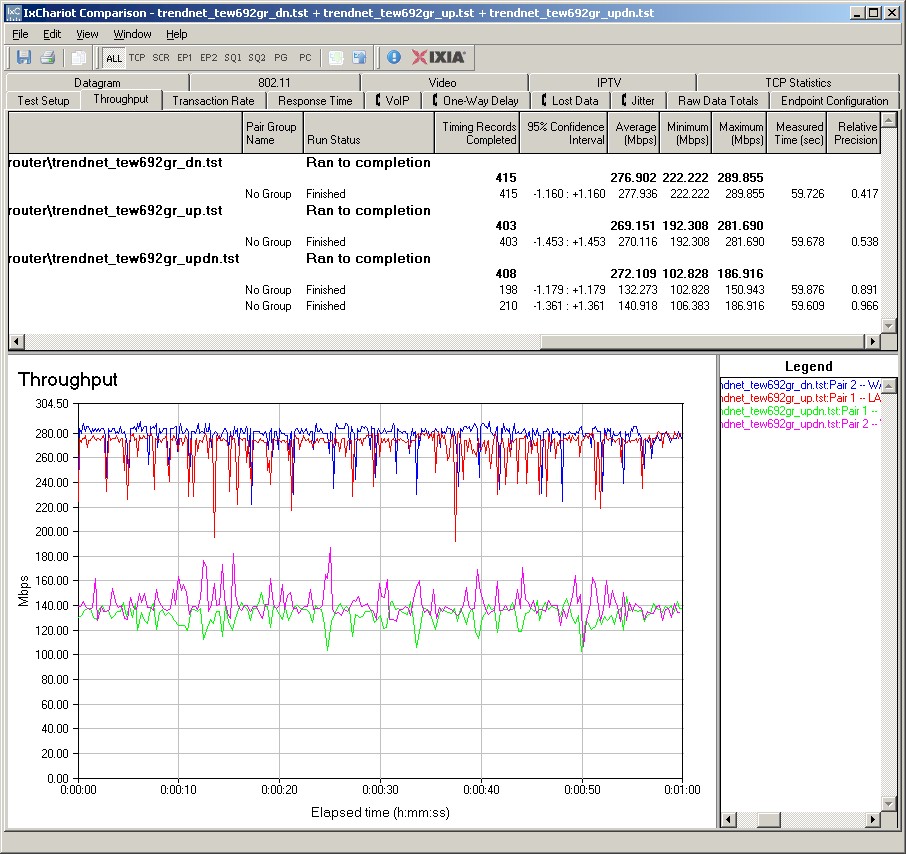
Figure 5 : TRENDnet TEW-692GR routing throughput
The Maximum Simultaneous Session test topped out at 14,976, which is close enough to the 14,983 sessions measured for the TEW-691GR to be considered the same.
Wireless Performance – 2.4 GHz Two Stream
The 692GR is not Wi-Fi Certified, but it properly defaulted to 20 MHz bandwidth mode on the 2.4 GHz radio on power-up, as it also did for the 5 GHz band.
I was able to run a Wi-Fi Protected Setup (WPS) pushbutton session with my Win 7 client that resulted in a WPA2/AES secured connection to the 2.4 GHz radio. All tests were run with this secured connection using our new four-location wireless test process.
First, let’s look at the Benchmark Summary in Figure 6. The main takeaway here is that there isn’t a significant difference in two and three stream throughput when averaged across the four locations tested.
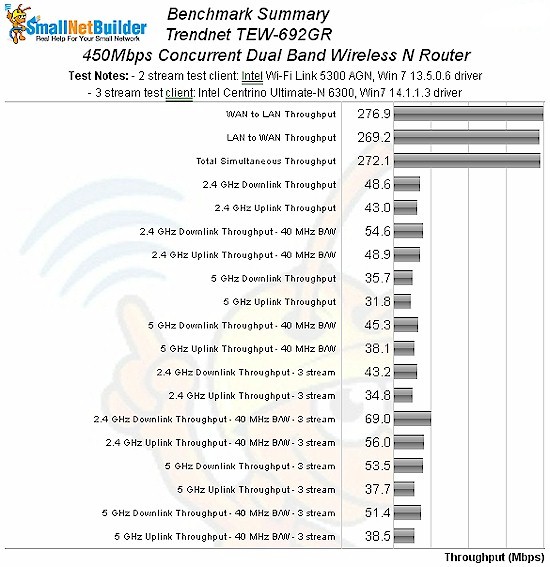
Figure 6: TRENDnet TEW-692GR benchmark summary
Although N routers that support three-streams in 2.4 GHz are harder to come by than those that provide this higher rate in the 5 GHz band, we’ve now got a few in the Charts database to compare: the TRENDnet TEW-691GR; D-Link DIR-665; and Gen 5 Apple Airport Extreme.
Figure 7 shows the wireless Performance Table for the four routers for 2.4 GHz and 20 MHz mode and neither TRENDnet turns in a particularly noteworthy showing.
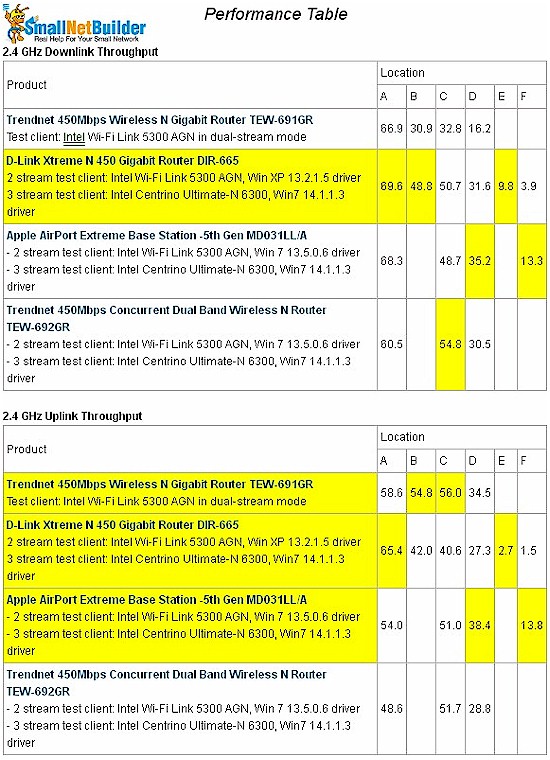
Figure 7: Wireless performance table – 2.4 GHz, 20 MHz mode, 2 stream
The real standout here is the inability of both TRENDnets to get enough throughput in Location F to run the IxChariot test. The odd thing is that in some cases the Intel 5300 client still maintained connection to the 692GR. But there wasn’t a good enough connection to even run a ping.
I’m not going to show a 40 MHz mode table because the Apple doesn’t support that mode and it doesn’t really provide that much more insight into relative performance.
I’ll note that best case throughput for the 692GR was 70 Mbps in Location A running downlink in 40 MHz bandwidth mode. And when running simultaneous up and downlink tests in that mode, I measured 91 Mbps of total wireless throughput.
Turning to the IxChariot plots reveals some interesting performance quirks. Figure 8 shows that even with strong signals, throughput is anything but nice and steady with periodic significant downward spikes. While it’s possible that this is an artifact from IxChariot, I doubt it because I use the same test file size on other products and don’t see this behavior.
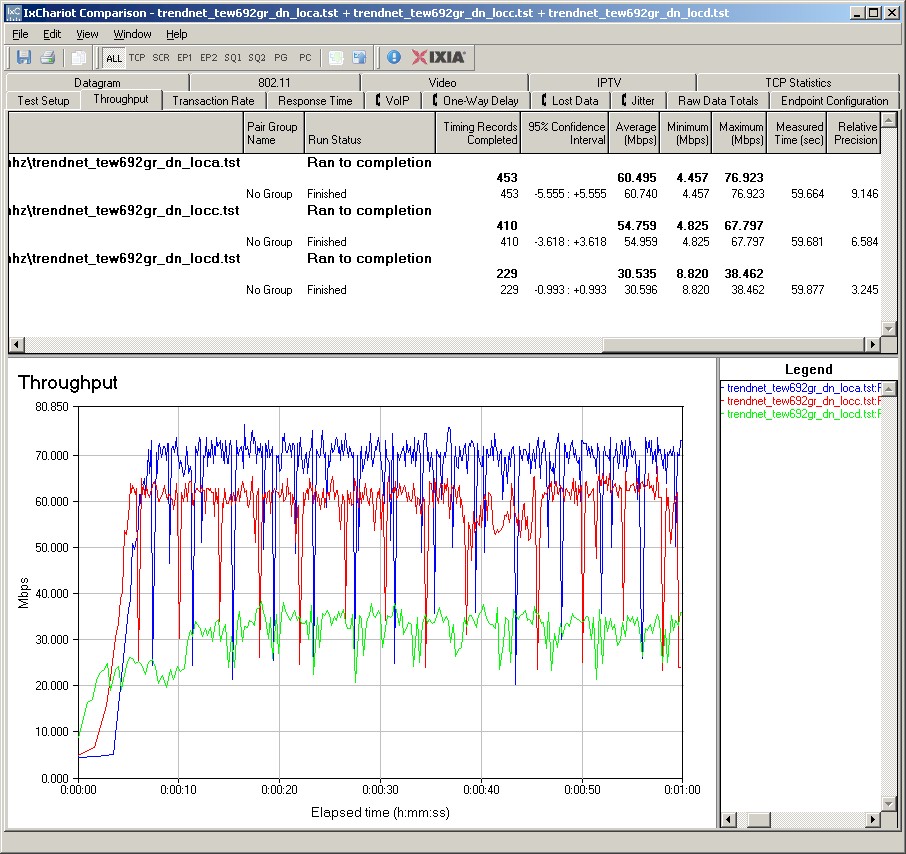
Figure 8: TRENDNet TEW-692GR IxChariot plot summary – 2.4 GHz, 20 MHz mode, downlink, 2 stream
The other thing you’ll see in this and most every other plot is the multi-second throughput ramp-up at the start of each run. This is definitely baked into the performance cake since I was unable to remove it with multiple test reruns.
Here are links to the other plots for your reference.
- 2.4 GHz / 20 MHz uplink
- 2.4 GHz / 20 MHz up and downlink
- 2.4 GHz / 40 MHz downlink
- 2.4 GHz / 40 MHz uplink
- 2.4 GHz / 40 MHz up and downlink
Wireless Performance – 2.4 GHz, Three Stream
Figure 9 shows the wireless Performance Table for the four routers for 2.4 GHz and 20 MHz mode, but now using the Intel 6300 Ultimate N three-stream client. The 692GR seems to like this mode better and was even able to complete Location F test runs, although with very low throughput
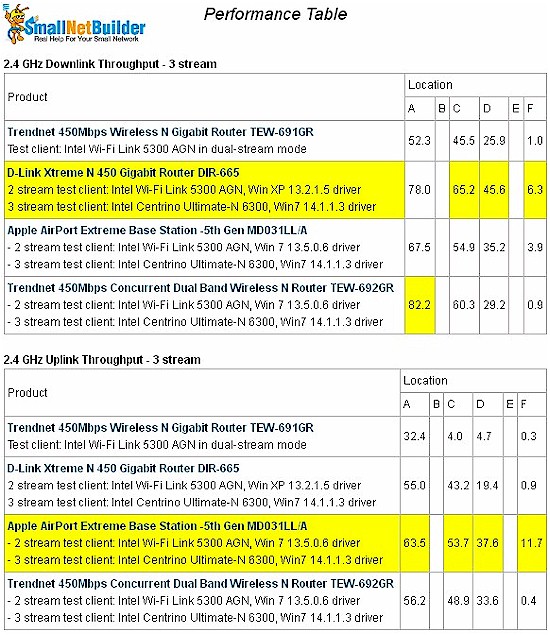
Figure 9: Wireless performance table – 2.4 GHz, 20 MHz mode, 3 stream
This time, best case throughput for the 692GR was 102 Mbps in Location A running downlink in 40 MHz bandwidth mode. And when running simultaneous up and downlink tests in that mode, I measured 130 Mbps of total wireless throughput. I’m again not showing the 40 MHz bandwidth mode tables
Figure 10 shows the IxChariot plots for 20 MHz mode downlink in three-stream mode. Throughput variation is still very high, but at least there is no ramp-up effect at the start of each run.
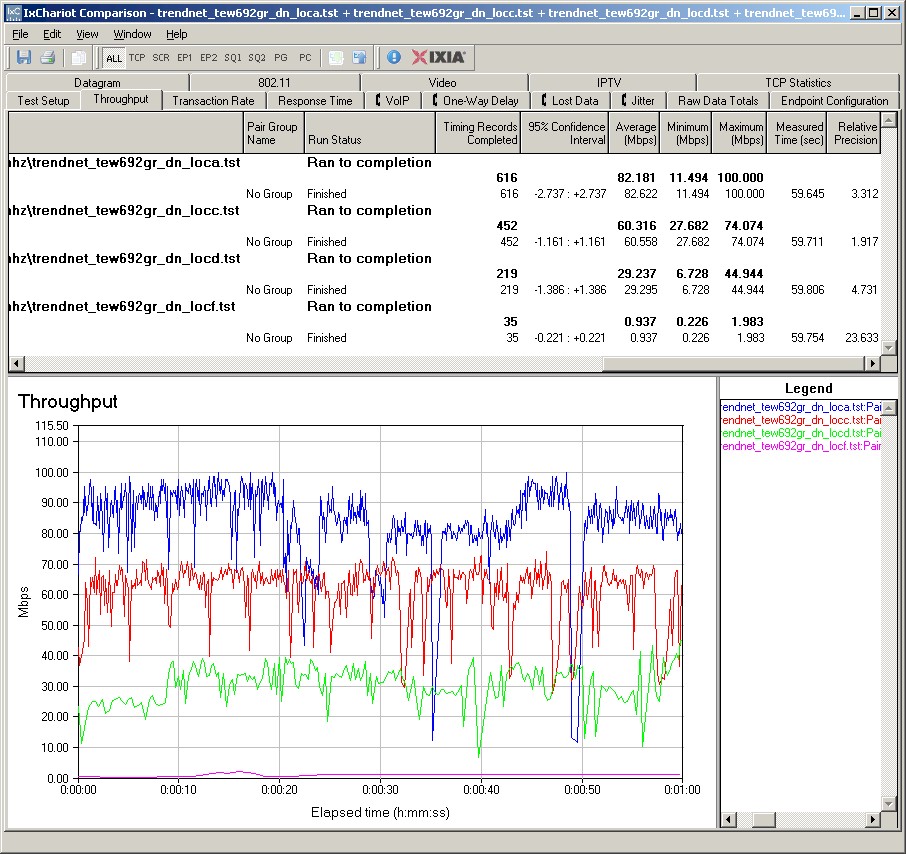
Figure 10: TRENDNet TEW-692GR IxChariot plot summary – 2.4 GHz, 20 MHz mode, downlink, 3 stream client
Here are links to the other plots for your reference.
- 2.4 GHz / 20 MHz uplink
- 2.4 GHz / 20 MHz up and downlink
- 2.4 GHz / 40 MHz downlink
- 2.4 GHz / 40 MHz uplink
- 2.4 GHz / 40 MHz up and downlink
Wireless Performance – 5 GHz, Two Stream
Since there are more recent (and popular) options for 5 GHz three streamers, I kept the 5th Gen Airport Extreme, but subbed in the Cisco Linksys E4200 and NETGEAR WNDR4000 for the DIR-665 and TEW-691GR.
Figure 11 shows the wireless Performance Table for the four routers for 5 GHz and 40 MHz mode, using the Intel 5300 two-stream client. I chose to show 40 MHz bandwidth mode for the 5 GHz comparison, since many of you will want to run that way for maximum throughput.
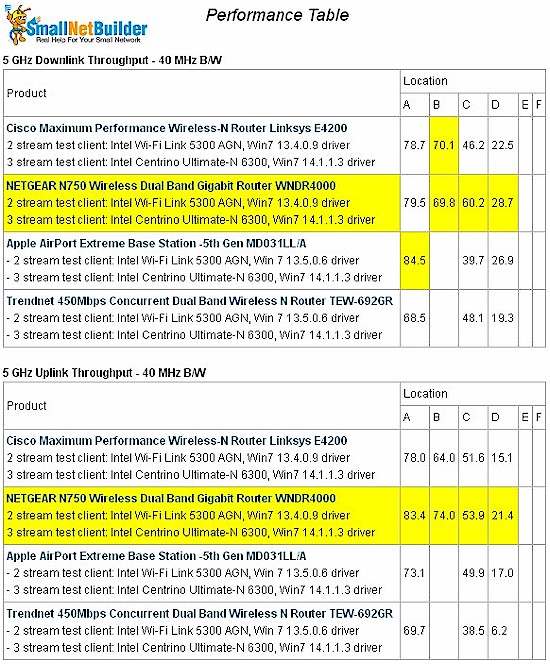
Figure 11: Wireless performance table – 5 GHz, 40 MHz mode, 2 stream
As is typically seen, none of the products reach to the weak signal test location F. The 692GR looks like the weakest performer, eking out only 70 Mbps of best case throughput. Running simultaneous up and downlink tests bumped that up to only 85 Mbps of total throughput.
Figure 12 shows the IxChariot plots for 5 GHz, 40 MHz mode downlink. That wonky oscillating throughput we saw earlier in the 2.4 GHz tests is back and looks worse, with higher variation. Note also the ramp-up affect at the beginning of some test runs.
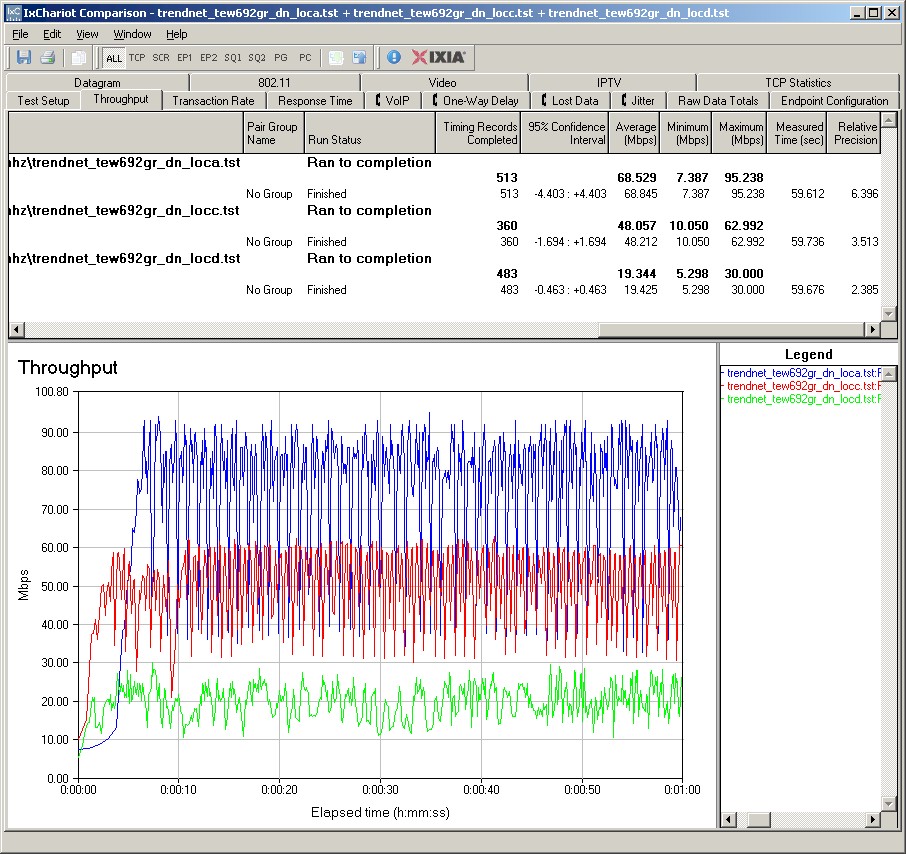
Figure 12: TRENDNet TEW-692GR IxChariot plot summary – 5 GHz, 40 MHz mode, downlink, 2 stream
Here are links to the other 5 GHz, 2 stream plots for your reference.
- 5 GHz / 20 MHz downlink
- 5 GHz / 20 MHz uplink
- 5 GHz / 20 MHz up and downlink
- 5 GHz / 40 MHz uplink
- 5 GHz / 40 MHz up and downlink
Wireless Performance – 5 GHz, Three Stream
We finally reach the last look at the 692GR’s performance—5 GHz, three stream using the Intel 6300 client and once again looking at the 40 MHz bandwidth mode data. Figure 13 shows the wireless Performance Table.
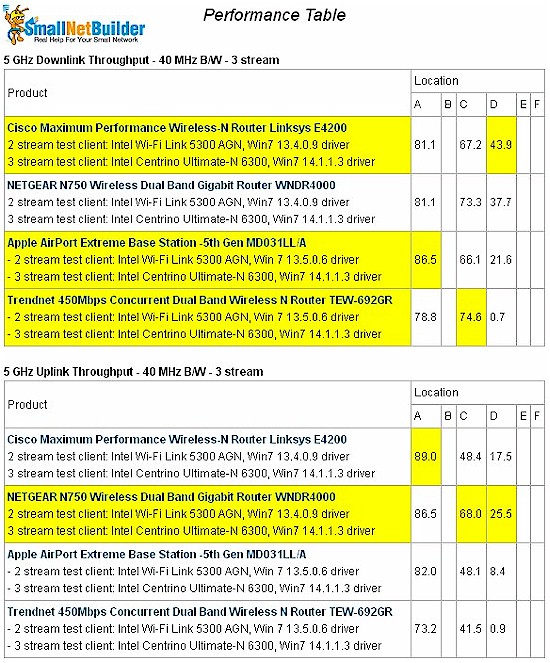
Figure 13: Wireless performance table – 5 GHz, 40 MHz mode, 3 stream
None of the products seem to really benefit from three stream operation, with only modest throughput gains shown. But the 692GR again looks like the weakest performer, measuring only 79 Mbps of best case throughput.
Running simultaneous up and downlink tests bumped that up to only 85 Mbps of total throughput.
Figure 14 shows the IxChariot plots for 40 MHz mode downlink in three-stream mode where the oscillating throughput is again evident.You’ll see this again in the 20 MHz bandwidth mode downlink plot, but not in any of the uplink or up / down plots.
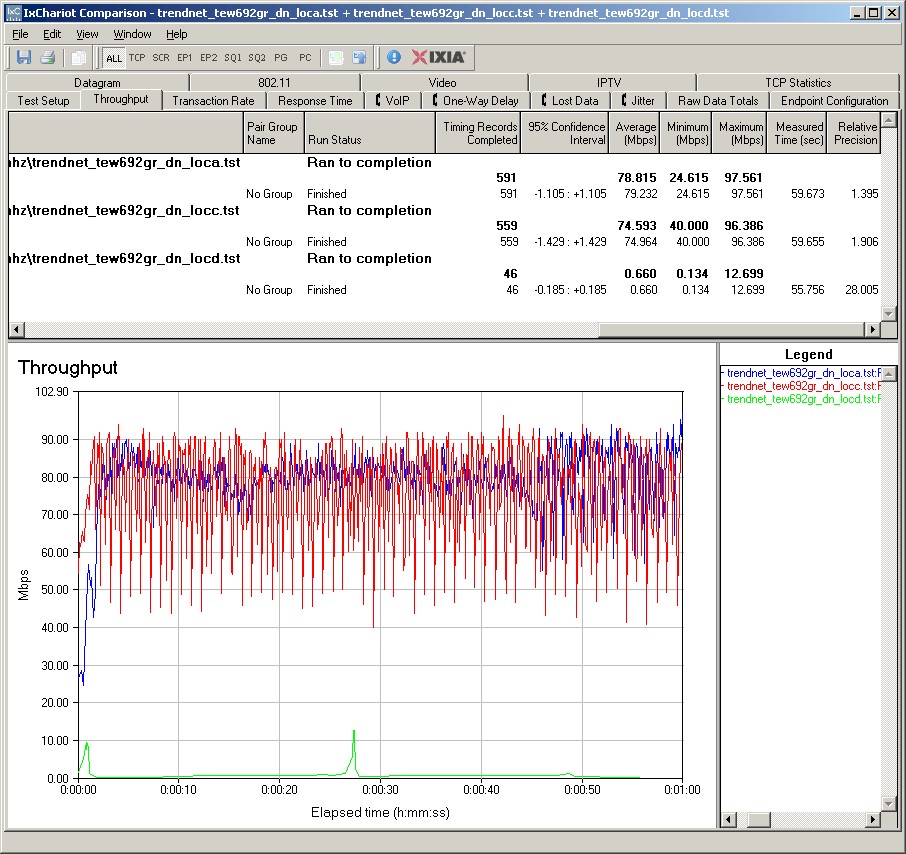
Figure 14: TRENDNet TEW-692GR IxChariot plot summary – 5 GHz, 40 MHz mode, downlink, 3 stream
Here are links to the other 5 GHz, 3 stream plots for your reference.
- 5 GHz / 20 MHz downlink
- 5 GHz / 20 MHz uplink
- 5 GHz / 20 MHz up and downlink
- 5 GHz / 40 MHz uplink
- 5 GHz / 40 MHz up and downlink
Closing Thoughts
I’m probably sounding like a broken record, but the TEW-692GR hasn’t done anything to change my mind about the value (or lack thereof) of three stream N. If you need further convincing, just look at Table 2. It pulls together the best case throughput from my testing for each of the eight test runs performed and shows the throughput improvement gained by switching from two to three stream N.
| Test Description | 2 stream | 3 stream | % change |
|---|---|---|---|
| 2.4 GHz – 20 MHz mode | 61 | 82 | 34 |
| 2.4 GHz – 40 MHz mode | 70 | 102 | 46 |
| 5 GHz – 20 MHz mode | 49 | 65 | 33 |
| 5 GHz – 40 MHz mode | 70 | 79 | 13 |
Table 2: Best case throughput (Mbps)
Keep in mind these are best case gains. In many cases, and especially once signal levels drop to medium and lower signal levels, the performance gain is much less, if anything at all.
It’s interesting that the best gain happens to be for 2.4 GHz, 40 MHz bandwidth mode, the most bandwidth hogging, least neighbor-friendly mode you can run. And the least gain is for the mode you’d most want to use, i.e. 5 GHz, 40 MHz bandwidth mode.
At any rate, given its poor range performance even in 2.4 GHz and unimpressive 5 GHz performance, I have to say that TRENDnet’s TEW-692GR isn’t the best choice you could make if you just have to have three-stream N in both bands simultaneously.
 Buy 450Mbps Concurrent Dual Band Wireless N Router from Amazon
Buy 450Mbps Concurrent Dual Band Wireless N Router from Amazon
